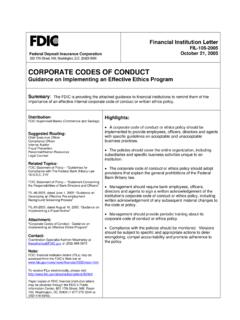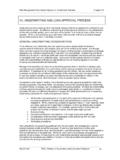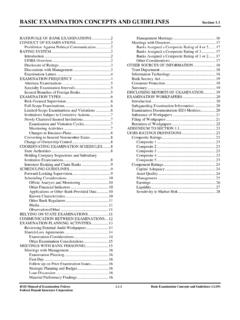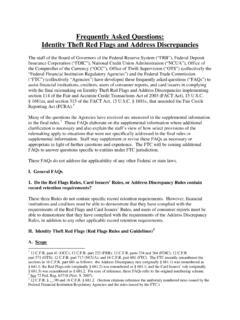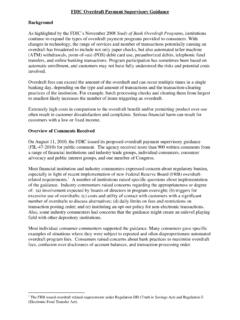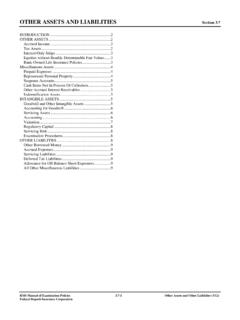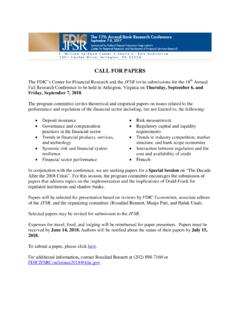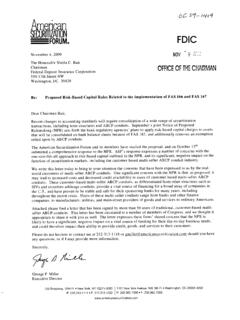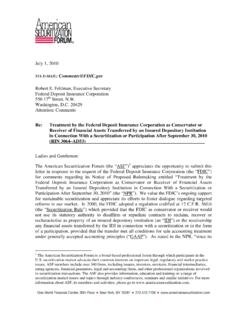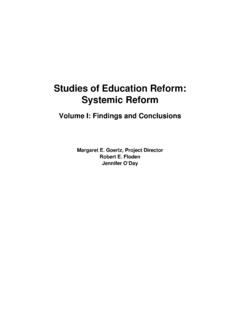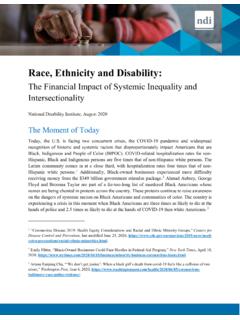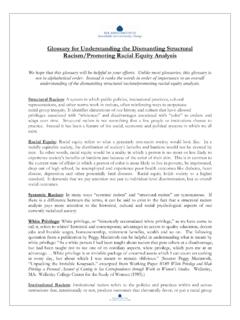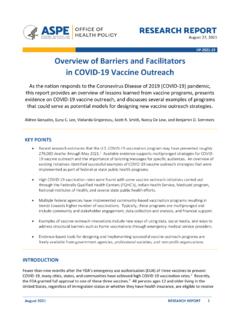Transcription of Crisis and Response: An FDIC History, 2008–2013
1 Xi Overview Introduction In 2008, the United States was confronted with its most severe financial Crisis since the Great Depression. The financial Crisis , in turn, resulted in a prolonged economic contraction the Great Recession with effects that spread throughout the global economy. Many books and papers have been written on the causes and implications of the financial Crisis of 2008 and 2009.
2 This volume reviews the experience of the FDIC from 2008 to 2013, a period during which it was confronted with not one but two interconnected and overlapping crises. First, the financial Crisis in 2008 and 2009 threatened large financial institutions of all kinds, both inside and outside the traditional banking system, and thus endangered the financial system itself. Second, a banking Crisis , accompanied by swiftly increasing numbers of both troubled and failed insured depository institutions, began in 2008 and continued until 2013. For a chronology of significant events over this period, see the timeline that appears at the end of this overview.
3 The two crises put the FDIC in the position of having to face multiple challenges simultaneously. In response to the financial Crisis , the basic problem was the need to contain systemic risk and restore financial stability. To achieve this, the FDIC took unprecedented actions using emergency authorities. In response to the banking Crisis , the FDIC had to deal with challenges relating to bank supervision, the management of the Deposit insurance Fund, and the resolution of failed banks challenges similar to those the FDIC had faced in the banking and thrift Crisis of the 1980s and early 1990s.
4 This study examines the FDIC s response to both crises and seeks to contribute to an understanding of what occurred and also to present some lessons the FDIC has learned from its experience. The study is divided into two parts. Part 1 focuses on the financial Crisis of 2008 2009 its causes and the FDIC s response and Part 2 focuses on the FDIC s response to the banking Crisis of 2008 2013. As delineated in the first chapter of Part 1, the causes of the financial Crisis lay partly in the housing boom and bust of the mid-2000s; partly in the degree to which the and global financial systems had become highly concentrated, interconnected, and opaque; and partly in the innovative products and mechanisms that combined to link homebuyers in the United States with financial firms and investors across the world.
5 As delineated in the remaining two chapters of Part 1, the financial Crisis that followed the housing market s collapse was so severe that, for the first time, the government turned to a statutory provision that had been put in place as part of the federal Deposit insurance corporation Improvement Act of 1991 to help it deal with systemic risks. xii Crisis AND RESPONSE: AN FDIC HISTORY, 2008 2013 This provision prohibited assistance to failing banks if FDIC funds would be used to protect uninsured depositors and other creditors but the act also contained a provision allowing an exception to the prohibition when the failure of an institution would pose a systemic In 2008, by relying on the provision that allowed a systemic risk exception, the FDIC was able to take two actions that maintained financial institutions access to funding.
6 The FDIC guaranteed bank debt and, for certain types of transaction accounts, provided an unlimited deposit insurance guarantee. In addition, the FDIC and the other federal regulators used the systemic risk exception to extend extraordinary support to some of the largest financial institutions in the country in order to prevent their disorderly failure. Accompanying the financial Crisis was the banking Crisis , which challenged every aspect of the FDIC s operations, not only because of its severity but also because of the speed with which problems unfolded. Focused on specifically in Part 2 of this study are (1) bank supervision (how significant was industry risk, what were the characteristics of troubled and failed banks, what role was played by bank examinations and other supervisory efforts before and during the Crisis , and how effective were these efforts); (2) management of the Deposit insurance Fund and the methodology used for assessing banks for deposit insurance coverage, both before and during the Crisis (what changes were made and what extraordinary measures were required).
7 And (3) the resolution of the hundreds of banks that failed during the six-year period (what methods did the FDIC pursue and how effective were they). In the remainder of this overview, a brief account of the magnitude of the problems the FDIC faced is followed by synopses of the study s six chapters, a brief conclusion, a postscript about the banking industry in 2017, and a timeline of the Crisis period. The Magnitude of the Problems It is important to recall just how significant both of these crises were. The financial Crisis and the recession with which it was associated were the worst economic dislocation since the Great Depression.
8 There were large losses in economic output and large declines in employment, household wealth, and other economic indicators. Not only did the economy lose million jobs, but half of those losses occurred within the six months that immediately followed the height of the financial Crisis in the autumn of 2008. In 2009, the year when foreclosures peaked, million mortgage loans were in foreclosure, almost four times the number in The cumulative net cost to the economy has been estimated by the Government Accountability Office and 1 See pp. xii-xiii for further explanation of the systemic risk exception. 2 These are FDIC estimates based on data from the Mortgage Bankers Association and the American Housing Survey.
9 OVERVIEW xiii others to range from more than $10 trillion to $14 trillion in today s dollars, or up to roughly 80 percent of an entire year s gross domestic As for the financial Crisis , its severity was reflected in the size of the government s emergency response. The federal Reserve initiated numerous programs designed to provide short-term liquidity to banks and other financial institutions as well as to borrowers and investors. In the six weeks following the September 15, 2008, bankruptcy of the investment bank Lehman Brothers, the federal Reserve s balance sheet doubled to about $2 On September 19, the Department of the Treasury announced that it would provide a guarantee for money market mutual funds, standing behind more than $ trillion in On October 3, Congress authorized $700 billion to fund the Troubled Asset Relief Program (TARP)
10 , and about $245 billion of that would be used to shore up the capital of financial Ten days later the FDIC announced its Temporary Liquidity Guarantee Program that would eventually guarantee more than $600 billion in debt issued by financial institutions and their At the level of individual firms, JPMorgan Chase s acquisition of the investment bank Bear Stearns in May 2008 was facilitated by a $29 billion loan from the federal Reserve Bank of New Yo r k .8 The multinational insurance corporation American International Group (AIG) initially was rescued with an $85 billion credit facility, also from the federal Reserve Bank of New Fannie Mae and Freddie Mac, two government-sponsored enterprises that support the mortgage market, were taken into government conservatorships that the Treasury would eventually support with a total investment of $ The banking Crisis , too, was severe.
